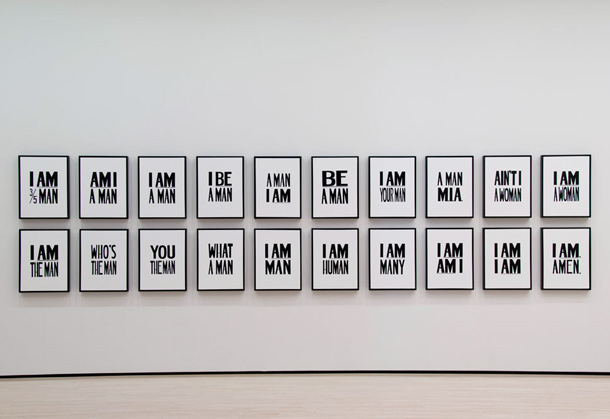
Hank Willis Thomas, I am a Man (2009), image courtesy of Jack Shainman Gallery
This essay was first published in Nowiswere issue 11. Written in 2012, it explores the idea of the commons in relation to how we use and view words. In the 21st Century, much has already been said about a need for a new lexicon. The concepts of the previous century, such ideas as freedom, democracy and equality, have become abstract voids that seem to make little sense to us anymore. Since the Arab uprisings of late 2010 and 2011, and the movements that erupted in the world thereafter, from the Indignant movements to Occupy, we are in a moment when the definition of collective action, and indeed, organization, are both being recalibrated. In this moment, therefore, words have become open to redefinition. What does it mean to be free? What does it mean to be collective? Like with any constitution, it is time we consider the constitution of the very terminologies that have come to define who we are and the societies we live in. It is time we look at words as territories of potential.
“There has been a constant search for a term to describe a human being in the widest sense.”
– G.L Brook, Words in Everyday Life [1]
A lot has been said about ‘the commons’, often defined as natural resources managed and distributed in common. It is a notion that was outlined in Elinor Ostrom’s 1990 Nobel Prize winning publication, On Governing the Commons: The Evolution of Institutions for Collective Action. In the text, Ostrom investigates sustainable practices in the governance of common pool resources – fisheries, water basins, irrigation systems – that works against a popular “presumption that an external Leviathan is necessary to avoid” what has often been termed, the tragedy of the commons – the idea that communities are incapable of sharing resources fairly, which inevitably leads to “recommendation that central governments control most natural resource systems.”[2] Ostrom’s text was in part a reaction to Garrett Hardin’s influential 1968 essay, “The Tragedy of the Commons,” in which Hardin observes “[Thomas] Hobbe’s parable of man in a state of nature [as] a prototype of the [commons tragedy]: Men seek their own good and end up fighting one another.”[3]
What Ostrom sought to debunk in her groundbreaking study – which used the inshore fishery at Alanya, Turkey, as an example of a common pool resource organised as a managed territory (these were fishing sites that were collectively managed by local fisherman according to guidelines they devised that ensured fair and equal distribution of fishing grounds) – was this idea that individuals need to be protected from self-interest: what Thomas Hobbes’ Leviathan or social contract sought to control. Thus what Ostrom did in her study was present the Alanya fishing grounds as a common space: a site of constant negotiation between its stakeholders. This is a view of the commons that deviates from Hardin’s “Tragedy of the Commons” and moves closer to Lewis Hyde’s own reading of a “A true commons [as] a stinted thing.” As Hyde wrote: “What Hardin describes is not a commons at all but what is nowadays called an unmanaged common pool resource.”[4]
Indeed, for Hyde, one of the greatest misconceptions is that the commons is a free-for-all. Reading the evolution of the commons through land distribution in the Middle Ages – when villagers held collective rights to common lands – Hyde explains how historically, the commons and markets were managed to suit social and moral ends, where “no one was left to follow his or her own ends without regard for the group.” Hyde recounts historian E.P Thompson’s citing of a 1768 pamphlet emphatically protesting against the supposed liberty of every farmer to do what he likes, stating that this would be a “natural” rather than “civil” liberty.[5] As Hyde wrote: “To these eighteenth century eyes, a stinted market, one constrained by moral concerns, is a social market, while a wholly free market operating without limits is savage.”[6]
Such tensions between “civil” and “savage” freedom are also present in the management of the cultural or information commons. As Michael Hardt points out, there is a tendency to take information, cultural products and codes as quasi-natural or at least given, like natural resources. Thus, the same issues of control seep into the management of such resources. In these cases, notes Hardt, the commons function as “a critique of how assigning property rights to immaterial goods prevent them from being shared.”[7] This view feeds into the debates on the Creative Commons and online file sharing, now under threat by increasing Internet legislation. And yet, as Brad Lichtenstein notes, the cultural commons are first and foremost something that is created together, and secondly a space that creatively “embraces values like sharing, community and stewardship as opposed to privatization, enclosure and exploitation.”[8]
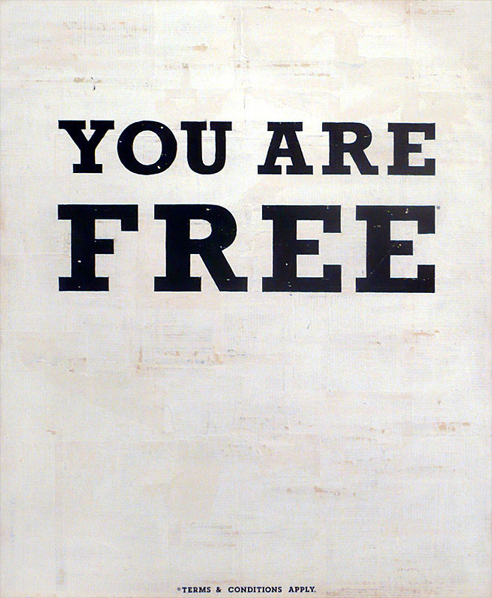
Kareem Rizk, YOU ARE FREE, NO.5 (2011), image courtesy of Phonebooth Gallery
Here, we see the drive to horizontally manage cultural or information commons in a way that reflects Ostrom’s example of Alanya’s inshore fishery. In this sense, we might think of the commons, from the water we drink to the data we transmit via the Internet, as a materially or immaterially defined territory upon which terms of agreement and common modes of being are negotiated and established. This could include the management of energy resources in physical territories, to social media networks, to national institutions, to the ownership of publicly funded artworks, and even to the management of an ideology, from Socialism, Communism, and Democracy. If that is the case, let us consider Kareem Rizk’s 2010 work, YOU ARE FREE NO. 5. The statement comes with a disclaimer, *terms and conditions apply, suggesting a civil contract – a stinted freedom managed in common. Of course, in the disclaimer’s relationship to aggressive marketing techniques designed to blindside consumers, it could also suggest a more insidious, savage freedom: The kind Hobbe’s Leviathan was formulated to constrain.
At this point, Rizk’s sign becomes a common of sorts, a space of contention – a territory – that echoes Hardt’s interpretation of Jacques Ranciere’s definition of the common (le commun):
The common, of course, is not the realm of sameness or indifference. It is the scene of encounter of social and political differences, at times characterized by agreement and at others antagonism, at times composing political bodies and at others decomposing them.[9]
When it comes to Rizk’s statement, the question is this: under whose terms and conditions are we free? Under what parameters is freedom defined? What does it mean to be free and who could describe the true meaning of freedom? The very attempt at defining freedom begs the question: to whom does our freedom belong?
For Sartre, one aspect of freedom is that it is a metaphysical absolute – something that is inherent in all of us. His description of intentional action illustrates the act of being free as a moment of toil, and it is worth quoting him here in full:
It is strange that philosophers have been able to argue endlessly about determinism and freewill, to cite examples in favour of one or the other thesis without ever attempting first to make explicit the structures contained in the very idea of action. The concept of an act contains, in fact, numerous subordinate notions which we shall have to organize and arrange in a hierarchy: to act is to modify the shape of the world; it is to arrange means in view of an end; it is to produce an organized instrumental complex such that by a series of concatenations and connections, the modifications throughout the whole series finally produces an anticipated result. But this is not what is important for us here. We should observe that an action on principle is intentional.[10]
This description shows action to be a moment of organization, even management: a moment one enters the role of craftsman in the arrangement, even modification of the world’s shape. It recalls 20th Century American poet and social activist Langston Hughes, who was closely associated with the Harlem Renaissance. In the poem, Freedom’s Plow, America is identified as a land created in common, driven by a dream nourished in common. Hughes writes that from free hands, slave hands, adventurous hands to indentured hands, “All these hands made America,” as he implores readers to be patient for the day that everyone in America is free. The land – a natural resource – becomes a metaphor for the freedom Hughes fought for, both for himself, and for those who sought such an existence in a land that promised to provide it. Here, America is the representation of an immaterial commons – the very idea of freedom itself.
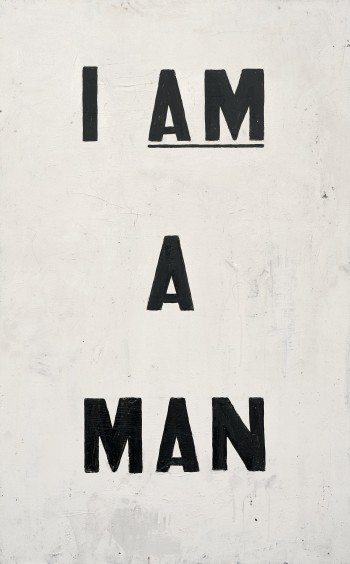
Glenn Ligon, I Am a Man (1988), image courtesy of Regen Projects
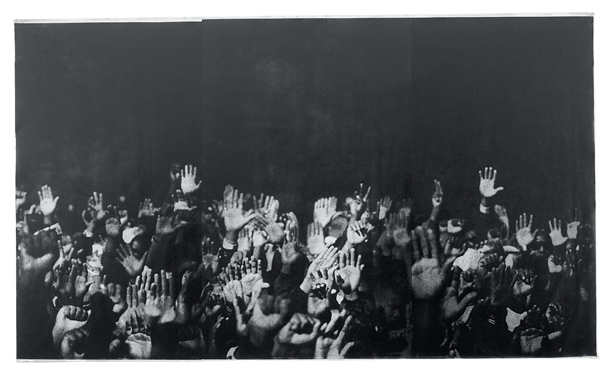
Glenn Ligon, Hands (1996), image courtesy of Regen Projects
Freedom’s Plow recalls the opening work in Glenn Ligon’s solo show, America, at the Whitney Museum in 2011: Hands, 1996, a screen-print of a photograph taken from the 1995 Million Man March against wage and employment disparities between black and white Americans, as well as the lack of black representation in the US government’s political agenda. Ligon’s hands, like Hughes’s, invoke the very hands that built America – hands that carry a history wrought with tension between master and slave. This linked to another work included in Ligon’s show: I AM A MAN, 1988, which references a protest sign used in a 1968 strike by African American sanitation workers in Memphis. These two works by Ligon suggest an imbalance – an inequality that recalls, as Sartre would describe it, an instance in a society when one class deprives members of another class their freedom in order to simulate their own.[11] It is what one might call a mismanaged commons – one that is not managed in accordance to moral or social interests.
And what Ligon’s two works suggest, along with the work of Langston Hughes in general, is a mismanagement of two specific common resources: equality and liberty, both contained within the very concept of America itself. And the issues are expansive, too, if Hank Willis Thomas’s own interpretation of the I AM A MAN sign (See top of page) is anything to go by, in that it offers various interpretations of what it might mean to be a “man”. Signs include, “I AM MANY” and “I AM HUMAN,” for instance. The theme extends onto gender, too. Consider the image of Sharon Hayes use of the ‘I AM A MAN’ sign as part of a 2005 performance in New York City, From In the Near Future. Both sign and statement, “I am a man,” like Rizk’s, “you are free,” become sites upon which politics might be deconstructed and reformed: the very words themselves, “MAN” and “FREE” become territories of definition – a lexical commons. Confronting such loaded statements – of insisting that one is indeed “a man” or is in fact “free” – thus forces individuals to contemplate the meaning of notions like manhood and freedom, in fact incredibly abstract concepts, within their own subjective experience. Is a woman a man? Am I free? In questioning what such statements mean, a word becomes a territory in its own right – a commons – open to multiple claims of ownership, belonging and ultimately, definition.
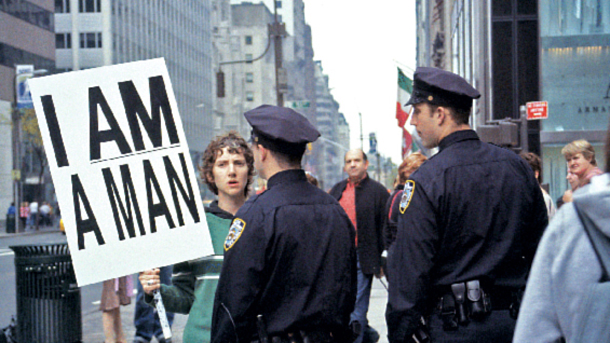 Sharon Hayes, From in the Near Future, 2005, image courtesy of Art Tattler
Sharon Hayes, From in the Near Future, 2005, image courtesy of Art Tattler
As G.L Brook notes: “Words are conventional symbols [that] bear […] the meaning which the speakers of a language have at any given time tacitly agreed to assign to it.”[12] Thus, to form notions, build meanings, and construct realities based on ideas, a general consensus is required that would enable the establishment of such notions in practice; a common agreement of what specific words mean on a collective level. Thinking back to Ostrom’s use of the inshore fishery at Alanya as an example of the spatial (or territorial) distribution of the commons organised collectively, and the idea of common word definitions as moments of consensus, could a word or a concept such as freedom thus require the same management, care, and protection as a natural commons?
Here, Steve Colbert’s definition of “wikiality” proves useful. Defined as a reality that becomes truth if enough people agree with a notion and define it, usually via a Wikipedia-like system, “wikiality” is a 21st Century “reality as determined by general [online] consensus.”[13] If so, what kind of reality is unfolding in a 21st Century where material and immaterial resources are either concentrated in or are falling into the hands of the few? As Massimo De Angelis noted in an interview with De Archtectkur for E-flux:
Especially against the background of the many crises that we are facing today—starting from the recent global economic crisis, and moving to the energy and food crises, and the associated environmental crisis—thinking and practicing the commons becomes particularly urgent.[14]
Indeed, this urgency extends into the question of what is and should be recognised as common today. In this discussion, let us not forget to include words and their concepts, including the very notion of freedom itself, and how it is (collectively) defined, distributed and managed in common.
[1] Brook, G.L. Words in Everyday Life (1981). London: Macmillan, 85
[2] Ostrom, E. On Governing the Commons: The Evolution of Institutions for Collective Action (1990). Cambridge: Cambridge University Press, 9
[3] Ostrom, E. On Governing the Commons: The Evolution of Institutions for Collective Action (1990). Cambridge: Cambridge University Press, 3
[4] Hyde, L. Common as Air: Revolution, Art, Ownership (2010). New York: Farrar, Straus & Giroux Inc, 35
[5] Ibid. 36
[6] Ibid. 36
[7] Hardt, M. On Production and Distribution of the Common. A Few Questions of the Artist. Courtesy of Foundation Art and Public Space: http://classic.skor.nl/article-4111-en.html
[8] Lichtenstein, B. Presentation at the National Alliance for Media Arts and Culture conference: http://www.namac.org/node/9207
[9] Hardt, M. On Production and Distribution of the Common. A Few Questions of the Artist. Courtesy of Foundation Art and Public Space: http://classic.skor.nl/article-4111-en.html
[10] Sartre, J-P. (tr.) Barnes, H.T. Being and Nothingness (1984). New York: Washington Square Press, 589
[11] “…exploitation of man by man . . . characterized by the fact that one class deprives the members of another class of their freedom” (Notebooks, 562, courtesy of Internet Encyclopaedia of Philosophy: http://www.iep.utm.edu/sartre-p/)
[12] Brook, G.L. Words in Everyday Life (1981). London: Macmillan, 3
[13] Urban Dictionary: Wikiality: http://www.urbandictionary.com/define.php?term=wikiality
[14] An Architektur, On the Commons: A Public Interview with Massimo De Angelis and Stavros Stavrides (July, 2010). E-flux Journal #17. http://www.e-flux.com/journal/on-the-commons-a-public-interview-with-massimo-de-angelis-and-stavros-stavrides/

I am curious your thoughts on the Constitution…what is its possible flaw? Is it a practical document, or is it an ideal? Also, how does the Tragedy of the Commons influence your interpretation of the Constitution?
“… freedom, democracy and equality, have become abstract voids …” Actually, there is a constant struggle in the arena of religion and law. Both tend to set up (written, at least verbal) rules that last centuries if not millennia. However, the wording’s use outside their remit begins to change. Eventually it becomes unclear and slightly unascertainable by each new generation if they are actually following the rules in their intended sense. While other groups try to use this uncertainty to change the rules without changing the wording. Which makes rules that were once by the “founders” to be set in stone actually quite malleable in a way the originators would have never considered possible nor “legal”.